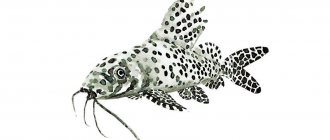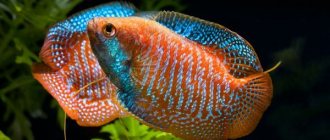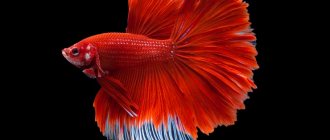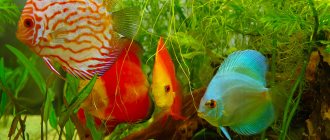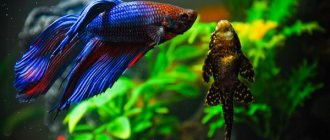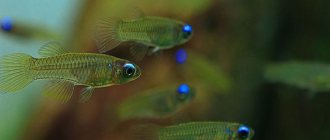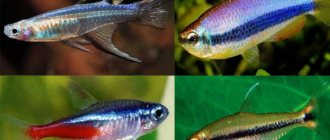Changeling catfish (lat. Synodontis nigriventris) is one of the smallest representatives of the genus Synodontis. Named for its inverted swimming posture, which makes it easier for it to feed on the surface of the water. It is an extremely popular species that has been admired for centuries; Their images have even been found in ancient Egyptian art. These are adorable fish and will make a wonderful addition to some types of aquariums.
Description
Synodontis ocellifer or synodontis changeling is a species of fish from the family Cirrus catfish. Naked catfish are considered a species due to the lack of scales. Instead of scales, the catfish's body is covered with mucus and is also protected by sharp fins.
Now the species is domesticated as an aquarium fish. Catfish are school animals. They live in small flocks of 4–8 individuals.
Appearance
The catfish is a fish with a massive and laterally compressed body. Representatives grow up to 15–30 cm. The head is large, flattened, with the presence of black spots. There are three pairs of whiskers on it. The lower whiskers are fringed or feathery, hence the name of the family. The dorsal and pectoral fins have sharp spines for protection. The caudal fin is well developed, a clear cut is visible. The color of the fins is dark.
The body color of shifter fish ranges from light to black. Individuals with a grayish-brown color are more common. On the back and sides there are dark spots that stand out against the general background of the body - black, red, gray, chestnut. Representatives with large black spots are more common. The abdomen is plain, without patterns.
Character
Catfish catfish are peaceful and non-aggressive inhabitants. The manifestation of aggression is provoked by fish leading a lifestyle similar to themselves - digging in the ground, staying in low layers of water. These individuals are perceived as potential enemies.
In other cases, catfish shifters are absolutely indifferent to other inhabitants of the aquarium.
Lifestyle
During the daytime, catfish are passive and inactive. They prefer to hide part of the day in algae and shelters in the aquarium, and stay awake at night. But some individuals are active during the day.
Behavior
The behavior of catfish shifters is similar to other species of catfish. They spend most of the day digging in the ground or hiding in a shelter.
Up to 80 percent of the time, catfish shifters swim belly up. The fish turn over and move around, feed and monitor their surrounding neighbors. Synodontis, which swims belly down, has a much darker belly than its back.
Lifespan
Synodontis fish can live up to 10 years at home. With improper feeding and maintenance, the lifespan of this catfish is significantly reduced to one or two years. In the wild they live for about 4–5 years.
Decorating the aquarium
Changeling is an aquarium catfish whose skin does not have bony plates. In addition, he has a rather delicate mustache and lips. All this requires a special approach to soil selection. It should not be too sharp or large. The best option may be rounded pebbles or coarse river sand.
Place dense vegetation at the back wall of the aquarium. The catfish will hunt in it at night. Plants with hard and large leaves are suitable for this purpose. Special artificial openings are usually placed in the foreground:
- large stones;
- grottoes;
- ceramic tubes;
- driftwood;
- small flower pots (without bottom).
When caring for a changeling, you have to catch it with a net from time to time. This must be done very carefully, as synodontis spreads spiny fins, which are very easy to damage. For this purpose, experienced aquarists often use glass jars of suitable size, to which special handles are attached.
The catfish is a calm and peaceful fish that prefers to live in a school. During the day it hides in shelters and is active at night. An aquarium with a volume of at least fifty liters is suitable for this fish.
Varieties
Changeling
Synodontis nigriventris was first discovered at the mouth of the Congo River. This is an ornamental African fish with unusual behavior. The fish spends most of its waking hours with its belly up: – the fish watches other inhabitants, looks out for food.
The body color is usually gray-brown with dark spots and lines. They grow up to 8–10 cm. They live 7–9 years.
Cuckoo
Cuckoo catfish or otherwise multispotted synodontis. It has a multi-pointed pale yellow color. Grows up to 15 cm.
Well kept with cichlids.
Veiled
Synodontis erupterus or veiled. It was called veil-shaped for its long, beautiful fins, which develop like a veil when swimming. Body color is brown-coffee with dark spots. The body size of veiled catfish is 15–20 cm, they live up to 10 years.
Angel
Synodontis angelicus or star-shaped synodontis. Many consider its beauty to be the most outstanding of the fish of the Cirrus family. Its beautiful appearance and decorative color make it a frequent pet in the aquarium. The body color is usually purple or coffee. It has spots of yellow or orange color. The body size is larger than many representatives - it reaches 25 cm. Angels live up to 15 years.
Flag
Synodontis decorus got its name - flag synodontis, because of the ray of the dorsal fin extended forward. The fish are gray in color with large dark spots. It grows up to 30 cm and lives for 15 years.
Other
There are also less common types of catfish:
- Dalmatian.
- Shoutedena.
- Scythe-fin.
- Nyassky.
- Leopard print.
- Brishara.
- Clown.
- Marble.
- Domino.
- Loti.
- Congo.
- Alberta.
A common feature of synodontis catfishes is dull coloration with the presence of multiple spots. All are distinguished by a calm disposition and lead a nocturnal lifestyle in low layers of water.
Fry
The incubation period lasts 172 hours, the fry that are born react negatively to sunlight. Therefore, the pond should be darkened. They begin to eat and swim on the fifth day. The fry are fed live dust.
Young synodontis initially swim like ordinary fish in an aquarium. Only after ten weeks do they turn into real changelings - they turn upside down and swim like adult fish. It should be noted that juveniles grow rather slowly, so owners should be patient.
Content
Catfish quickly get used to being kept in an aquarium. The water should not be too hard and not too soft.
Aquarium
The size of the aquarium should match the size of the fish. For a 25 cm pet you will need a tank of about 200 liters. For smaller individuals – 120–150 liters.
There must be shelters in the aquarium. For each catfish, 1–2 shelters are provided. The soil should be round, without sharp edges. Sand, crushed pebbles and gravel are suitable. Aquarium equipment: aerating device, filter. They will maintain normal water for life.
The aquarium must be covered with a lid.
Water parameters
For the normal existence of skinwalkers, neutral acidity is necessary. The water temperature should not fluctuate sharply - within 25–28 degrees. The water is changed once or twice a week. Fish waste accumulates at the bottom of the aquarium, so cleaning is done. To clean, you need to siphon the soil. Partial cleansing occurs when changing the water.
Plants
The only requirement is that the plants should not have sharp edges or thorns, so that the delicate skin is not damaged. Stiff-leaved underwater plants are used, for example, Anubias, Congo fern, Aponogeton rigidifolia, Microsporum.
Plants should be planted quite deep, because catfish changelings love to dig through the soil in search of food. Or plant plants in pots.
Lighting
Catfish are undemanding when it comes to lighting. Any lamps are suitable, but not too bright, because catfish prefer darkened spaces.
Feeding
In nature, the changeling catfish feeds primarily on insects at the surface of the water, and it will often clear the undersides of submerged branches and logs of worms, insects, and microorganisms. Swimming upside down makes these areas easier to access.
In the aquarium, they easily adapt to all types of food, from dry to live and frozen. For optimal health, provide a varied diet that includes insect larvae whenever possible, especially bloodworms—the larvae of mosquitoes.
Changelings love to feed directly from the surface, although it is best to feed them in the late evening when their active period begins.
Sinking foods such as pellets, flakes or pellets are quite nutritious. However, synodontis also love live food, such as bloodworms, shrimp, brine shrimp or mixes.
You can add vegetables to the menu - cucumbers, zucchini. Half of the success of keeping synodontis is plentiful and nutritious feeding.
Compatibility
The compatibility of catfish shifters with other types of fish is high, due to their peaceful nature. On rare occasions they become aggressive. This usually happens if an individual of another species leads the same lifestyle as the catfish. Species that prefer to spend time at the bottom of the aquarium become enemies and invaders of territory in the eyes of the fish. This causes conflicts.
The best neighbors for catfish shifters will be cichlids and tetras.
Several fish of the same species have average compatibility. If the inhabitants are approximately equal in strength and size, then they will get along. But if one of them is weaker and smaller, then they will oppress him, bite him, and take away food. At the first signs of oppression, the individual is placed in a separate tank.
You should not keep changelings with small fish species or fry. At night they will be attacked by catfish or eaten.
Who can I combine with?
Speaking about compatibility with other fish, based on the experience of experienced aquarists, synodontis gets along best with species such as lalius, aulonocara, Jackson's haplochromis, rainbow fish - melanotenia, angelfish and Mbuna cichlids - relatives of catfish in their native African lakes. Synodontis is considered a peace-loving, quite intelligent and sociable fish. Owners of catfish that live next to a person for a long time can stroke their pets’ tummy, and often notice an attentive gaze directed at themselves when they are about to feed their charges. However, if a fish has settled in the aquarium, leading the same lifestyle as a catfish, then conflict is not far away. Therefore, it is worth choosing neighbors for such an unusual and cute predator more carefully.
See below for information on keeping a catfish.
Reproduction
There is not much information available about the breeding of Synodontis and some are disputed by scientists.
In the wild, individuals migrate to spawn during the rainy season. Therefore, some aquarists advise cooling the water a few degrees to approach spawning time.
Females lay their eggs in holes or depressions that they find in advance. The female is capable of laying about 400 eggs.
After 5 days, catfish fry hatch from the eggs. At a young age they usually swim. But after 6 weeks they become like adult fish and turn over in the water. The fry feed on brine shrimp and small worms.
How to determine gender
There are no clear distinguishing features between male and female catfish shifters. Males have a more graceful and slender body structure and are usually smaller, while females are plumper and rounder, especially in the abdominal area. In males, a small genital outgrowth is located near the anal fin. Female skinwalkers have much larger spots on their body than males.
Breeding Synodontis
They are rarely bred in aquariums, and if they are bred, it is mainly due to hormonal injections. They become sexually mature at the age of 1 year. For breeding by couple, producers use a capacity of 70 liters. Before spawning, the spawners are seated for 1-2 weeks and fed generously. A safety net is installed above the bottom. The temperature is 2-3°C higher than at which they were kept before. When feeding, the part of plant food should be at least 30%. The stimulus for spawning is the replacement of part of the water with fresh water and a strong current. Spawning usually begins on day 2-3, and proceeds in different ways. One pair can be in the pipe and spawn there; the spawned eggs are freely carried away by the current of water. In another case, the process can occur between two large stones or in the thick of a synthetic substrate, but always in the flow. The eggs are brownish-reddish in color, slightly elongated, about 1 mm. From one female you get up to 500 pieces. The bulk of the eggs is concentrated in the zone where the flow of water is almost not felt. The development of eggs occurs as follows: after 6-12 hours, unfertilized eggs turn white. Such eggs are very quickly attacked by Saprolegnia, so they must be removed from the general mass to prevent infection from occurring. Healthy eggs, at 26°C, develop in about 40 hours. Next, you need to darken the entire container, because... the larvae have a negative reaction to light and therefore try to move to the least illuminated places. On the fourth day, the yolk sac of the larvae dissolves and the fry begin to feed. Live dust and Artemia nauplii are used as starter feeds. As they grow, they switch to larger feeds. When giving tubifex, you need to carefully monitor the quality of the water, because... in this case, ciliates begin to multiply intensively, which simply kill the fry. Therefore, it is necessary to promptly remove the remains of the cut tubifex. It is good to place with them juvenile Ampularia or Red Coil snails. The fry grow unevenly, but there is no need to sort them.
- Apistogram
- Siamese Algae Eater, SAE
- Pseudocat Seville
Habitat in nature
In nature, fish live in various parts of Africa (rivers and lakes of Congo, Ivindo, Zambezi, Victoria, Tanganyika). Used by the local population as food.
Found only in fresh waters. They feel good both in muddy and dirty water and in clean water. In water they prefer to live in places with a rocky bottom, with a small amount of sand.
Diseases
Changelings are hardy fish with strong immunity. Most diseases bypass them. Immune to diseases that affect other species from the tropics.
Possible diseases:
- Obesity. Catfish tolerate hunger well and can go without food for several days without any problems. But overfeeding is dangerous. Especially food of animal origin. To return the body to normal, it is necessary to reduce the amount of food and arrange days without food once or twice a week to maintain tone.
- Stress. A symptom of stress is a pale, dull body color. Causes of stress: overcrowding of the aquarium, aggressive neighbors, lack of food. Observe the changeling and determine the cause of the stressful condition. Only then begin treatment.
- Oxygen starvation. It is easy to detect a lack of oxygen - the fish are lethargic, inactive, often open their mouths, and swim sideways. The cause of oxygen starvation is a breakdown of the aeration device. Hydrogen peroxide is added to quickly increase the oxygen level in the water.
- Fin rot. Bacteria live at the bottom of the aquarium. When a fish is weakened or sick, it lies on the bottom for a long time. This will lead to the appearance of putrefactive formations on the body. Treated with a streptocide bath.
Diseases
Veiled synodontis is a very hardy fish that very rarely encounters diseases. At the same time, Synodontis is susceptible to diseases that affect other tropical fish species.
A high concentration of nitrates in water can lead to infectious damage to the antennae, which will make it difficult to navigate in space and negatively affect nutrition. The level of nitrates in water should not exceed 20 ppm.
The best prevention of disease is to provide a healthy living environment and a balanced diet. The closer the conditions are to natural, the less likely there is to be stress? and the more healthy and comfortable the life of your fish will be. Stress increases the risk of disease.
Please remember that anything you put in your aquarium can become a source of infection. This is not only fish, but also plants, soil, and decorative items. Before placing a new item in the aquarium, make sure it is clean and, if possible, disinfect it.
Since synodontis lack scales, they can be treated with pimafix and melafix. Do not use potassium permanganate or copper-based medications. The permissible amount of malachite green or formaldehyde is 1/2 -1/4 of the recommended dose. Medicines should be used with caution. —— animal-world.com/encyclo/fresh/catfish/spotsynodontus.php www.seriouslyfish.com/species/synodontis-eupterus/
Reviews
Most aquarists and catfish breeders note their quiet and peaceful character. Fish coexist seamlessly with all types of fish. Breeders love to watch the strange and unusual antics of the aquatic pet. Because of this, catfish are so popular.
Adviсe
- Keep 2–5 catfish.
- Set up a couple of covers.
- Don't overfeed catfish.
- Don't put them near small fish.
- Use only smooth primer without sharp corners.
Be sure to get these changeling fish. After all, in Japan there is special respect for catfish, because according to the Japanese legend about the structure of the world, the earth is located on the back of the great catfish Namazu.
Previous
Varieties of Tarakatum keeping and caring for catfish: difference between male and female fish, reproduction (breeding) at home, spawning, compatibility, description, photo
Next
Varieties of Ancistrus vulgaris catfish (fish stuck): maintenance, care, breeding, types, description
Great article 0
